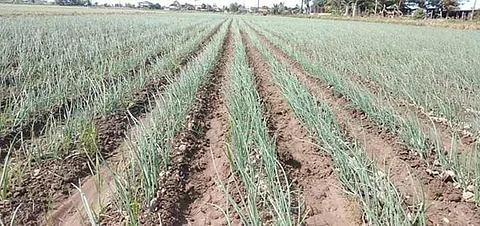

HIGHER production of onion and Bacillus thuringiensis (Bt) corn are projected this year, according to the Department of Agriculture (DA) regional office in Central Luzon.
DA Regional Director Crispulo Bautista said they are now looking for more alternative areas in Moncada town, Tarlac to complement the onion production in Nueva Ecija province.
Central Luzon has 11,000 hectares of land planted with onions.
Of the total, 9,000 hectares are in Nueva Ecija, contributing 50 to 60 percent of the entire onion production in the country.
Tarlac has 2,000 hectares devoted to onions.
Other onion-producing areas in the country are Mindoro, Iloilo, and the Ilocos region, which produces the native onion variety.
Onion
Central Luzon region produces an average of 10 to 15 tons of onion per hectare during the harvest season. And to help with storage needs, the DA recently lead initial groundwork on a P190-million cold storage facility, which is set to be constructed in Barangay Caballero, Palayan City.
In the past, farmers are often forced to market their produce at a low price due to the lack of storage facilities. But with the construction of the cold storage facility, the DA hopes to enable farmers to store their produce in safe custody and obtain a good price in later sales.
The construction will be closely monitored by the PRDP I-Build Component supervised by Rural Infrastructure Engineer Bon Alexis Guatato and expected to be operational by 2020 with an initial 120,000 bags capacity.
Bautista said that they are now looking at other measures to the problem of recurring armyworm infestation, particularly in Bongabon, Nueva Ecija through effective pest control measures and pest resistant onion varieties.
The Philippine Statistics Authority (PSA) reported that in April to June 2018, production of the bermuda onion decreased by 14.8 percent from 44.62 thousand metric tons in the same quarter of 2017 to 38.02 thousand metric tons in 2018 due to armyworm infestations.
In 2018, Central Luzon was the top producer of bermuda onions at 19.74 thousand metric tons and shared 51.9 percent of the country’s total production. Also in the same year, production of native onions dropped by 1.0 percent, from 1.07 thousand metric tons in 2017 to 1.06 thousand metric tons.
With interventions in place, the DA is hoping for better onion production for the rest of the year. Onion planting season in Central Luzon starts during the cold-months of September and ends in December.
Bt Corn
The PSA said that Central Luzon’s total volume of corn production was estimated at 129.8 thousand metric tons during the first quarter of 2019. Data showed that this was higher by 4.2 percent than that of the same period in 2018.
Central Luzon ranked sixth in terms of corn production and contributed 5.4 percent to the total volume of corn production in the country, according to PSA statistics.
Corn is planted in Central Luzon provinces with Tarlac, accounting for at least 35 to 45 percent of the regional production, followed by Pampanga, Nueva Ecija, and Aurora.
Bt corn was first introduced in Central Luzon in the province of Tarlac. Its production soon spread to different provinces. From the initial 300 hectares of land devoted to corn production, this rose to 400,000 hectares for the whole region as of the current DA estimates.
Most of the Bt corn produce end up in buying stations and feed millers in Central Luzon, with some 45 percent of the of the country’s feed mill output comes from the region. Pampanga alone hosts some of the biggest feed mills in the country.
This vital position of Central Luzon assures the further cultivation of Bt corn. In Pampanga, contract growers cultivate Bt corn in large hectares of land in the towns of Mexico, Santa Ana, Arayat, and Magalang. The towns provide the good soil condition needed for growing corn aside from the fact that feed mills are located near or within these places.
If planted properly, Bt corn potential maximum yield is 17 tons per hectare through precision planting. The DA said that the cost of production usually hits 45,000 to 50,000 per hectare.
In the past, farmers would have to produce some 4.5 metric tons per hectare to break even on the expenses. The DA said the regional Bt corn performance is from 7 to 14 metric tons, a far cry from the non-Bt corn varieties used in the past.
San Manuel and Moncada in Tarlac alone produce some 12 metric tons, respectively. Bt corn yield assures double and even triple return of investment. Such is the economic potential of Bt corn that some 35,000 farmers in Central Luzon are now engaged in Bt corn cultivation.
A study conducted by Sikap-Strive Inc., said that in 2015 alone, some 702, 000 hectares were devoted to Bt corn production in the Philippines. The estimated microeconomic impact of genetically-modified corn technology in the country is estimated at P40,241 million.
As of 2017, some 500,000 farmers have cultivated Bt corn. The corn accounts for much of the industry production since 65 percent of all yellow corn produced in the country is in fact Bt corn.
Bt corn was the first, and so far, the only modern biotechnology product approved in the country for commercial production intended for livestock feed manufacturing. This was after undergoing the science-based biosafety system in the Philippines, which has become a model regulatory system among developing countries.